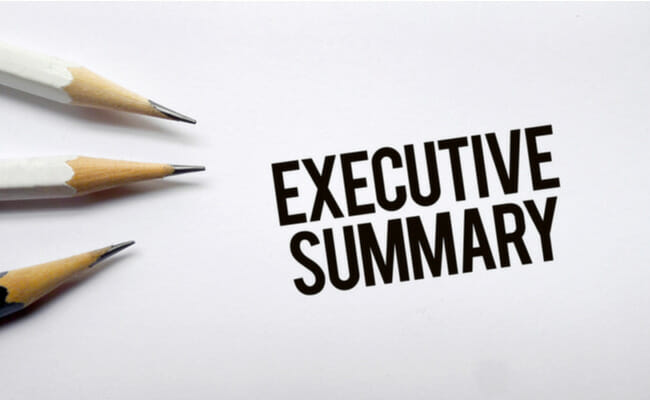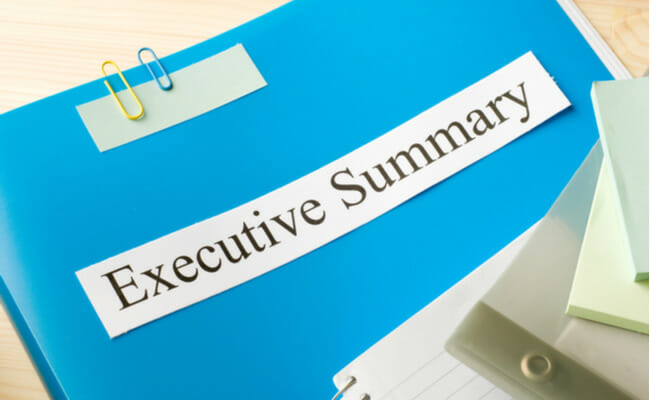How to write an executive summary
When you need initial backing or extra funding, you must write an executive summary. It’s a condensed version of your full business plan or marketing plan. You’ll need it because investors won’t have time to read several pages. With an executive summary, you can introduce your needs while discussing your proposal.
An executive summary should be short and sweet, so you will have to compose it as best you can. That’s easier said than done because it’s a balance of factual and relatable writing. You’ll have to present many hard facts in a way that your audience would like to read. Fortunately, I have the tips you need to write the best executive summary!
First, I will share more details about an executive summary and go through its various purposes. After that, I will cover the steps to writing your first drafts. I will only provide you with a general overview because you’ll have to add certain sections depending on the purpose. Later, I’ll share a few tips to refine your writing style and content.
What’s an executive summary?

An executive summary is a short document that goes through the key points of your plans to a group of investors or higher-ups in your company or another.
Think of it as an “elevator pitch,” but in written form. To get everyone up to speed, it’s a short proposal that should persuade someone in a few moments.
Like its namesake, an elevator pitch should make someone say “yes” before their elevator reaches their floor. An executive summary should be just as convincing.
This type of document should only be one to two pages long. What’s more, a summary should include the following parts;
- First, you must have an introduction that explains your concern or need. For a new project, you should explain what problem it should solve. Also, you must give an overview of what you need.
- Then, you must discuss how your project will solve the issue you wrote in the first part. In other words, you must lay out its goals and objectives.
- Next, talk about why that solution from the second step is important. Explain what will happen once you’ve finished your project. How will it solve or improve the issue from the first section?
- Lastly, wrap it all up by emphasizing why your project is important. Remind readers what your project is about.
When should a business use an executive summary?
Although an executive summary does not have a specific structure, there are certain rules to follow to ensure that your business plan or investment proposal receives the attention it deserves.https://t.co/YaXCV8i3UL
— MSME Hub (@MsmeHub) December 8, 2021
As I said, you might have to include other steps depending on your summary’s purpose. Here are the ways people often use this type of report to write a short version of the following:
- Business plan – Before your startup begins selling its products and services, you will probably need to convince someone to fund you. You may need to woo investors to provide capital or persuade a lender to get a small business loan.
- Business case – You need an executive summary when starting a new project in your company. Shareholders are also owners, so they should agree to your plan before going through with it.
Read More: The Benefits Of Press Releases For Business
Why is an executive summary important?
People submit this document to fellow professionals who are also quite busy. That’s why you’ll have to ask a lender, investor, or director to open their schedule for your pitch.
These decision-makers will need to know what your proposal is about within a short period. They will not give that much time to reading a full report.
On the other hand, they are more likely to read an executive summary. It’s just two pages long, and it’s often written interestingly.
Steps to writing an executive summary
We’ve talked about the executive summary definition. Also, I only mentioned two purposes for this type of report because they’re the most common ones. This article will drag on for too long if it covers them all.
First, let’s begin with the typical executive summary template for a business plan. These are the usual sections, so the ones you’ll need will depend on your goal:
- Company description
- Products and services
- SWOT Analysis
- Market Analysis
- Financial information
- Marketing Plan
- Funding request
Next, let’s talk about writing one for a project proposal. Here are the questions you must answer in your executive summary:
- What is the goal of your project?
- Why should your team take on this project?
- What problem will it solve?
- What makes your project special?
- How will you promote your project?
- What are the tools or services that your project needs?
- How much time will your project require?
- What will investors, lenders, or a board of directors get from this?
- What are your target audience and your competitors?
- Who are the people who will help you, and why are they qualified?
After all these steps, you have to conclude by reiterating your project’s goal. Don’t just copy and paste the intro here! Write it differently.
Executive Summary Tips
The templates might seem simple, but you will have to put more effort into writing an executive summary yourself. The first thing you have to do… is to write it last.
A “summary” is a shortened version of something much longer, such as a full business plan or market research. Otherwise, yours won’t have anything in it, or it may lack important details.
Once you have the materials, you may start writing your executive summary. Here are the steps you will need:
- Know your audience to make sure those folks would read the executive summary. You have to make sure they relate to your writing, so you’ll often avoid jargon. This doesn’t hold, though, especially if you’re discussing terms from technical topics.
- You also need to know your readers to write an eye-catching introduction. Your readers will only read the rest of your summary if it starts with an eye-catching introduction.
- Make sure you only cover relevant info, so your executive summary is focused. That way, you can keep it to two pages, and the reader won’t be confused.
- Lenders, investors, and directors should be able to read your summary without needing additional documents. It should be the only report they need to get the gist of your plan.
Final Thoughts
Once you have your first draft, check your executive summary. Make sure there aren’t grammatical errors or missing info. You have to do the same for your other documents.
Your reader may request those after reading your summary, so you must be ready to submit them. What’s more, writing this document will take some trial and error.
Revise it as many times as you need. You might want to talk to your team, so they can help in checking your summary.




